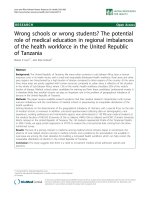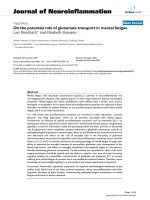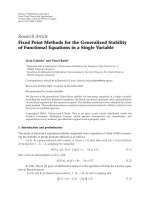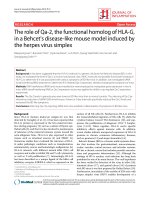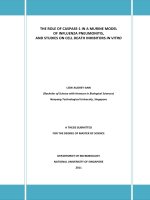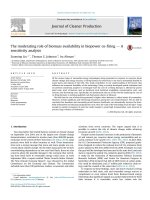The changing role of managerial accounting in a dynamic business environment
Bạn đang xem bản rút gọn của tài liệu. Xem và tải ngay bản đầy đủ của tài liệu tại đây (1.17 MB, 31 trang )
Chapter 1
The Changing Role
of Managerial
Accounting in a
Dynamic Business
Environment
McGraw-Hill/Irwin
Copyright © 2009 by The McGraw-Hill Companies, Inc. All rights reserved.
Learning
Objective
1
McGraw-Hill/Irwin
Copyright © 2009 by The McGraw-Hill Companies, Inc. All rights reserved.
Define Managerial Accounting
Managerial accounting is the process of
Identifying
Measuring
Analyzing
Interpreting
Communicating information
Learning
Objective
2
McGraw-Hill/Irwin
Copyright © 2009 by The McGraw-Hill Companies, Inc. All rights reserved.
Managing Resources, Activities,
and People
An organization . . .
Directing
Acquires Resources
Hires People
Organized
Organized set
set
of
of activities
activities
Controlling
Decision
Making
Planning
Learning
Objective
3
McGraw-Hill/Irwin
Copyright © 2009 by The McGraw-Hill Companies, Inc. All rights reserved.
How Managerial Accounting
Adds Value to the Organization
•• Providing
Providing information
information for
for decision
decision making
making and
and
planning.
planning.
•• Assisting
Assisting managers
managers in
in directing
directing and
and controlling
controlling
activities.
activities.
•• Motivating
Motivating managers
managers and
and other
other employees
employees
towards
towards organization’s
organization’s goals.
goals.
•• Measuring
Measuring performance
performance of
of subunits,
subunits, activities,
activities,
managers,
managers, and
and other
other employees.
employees.
•• Assessing
Assessing the
the organization’s
organization’s competitive
competitive position.
position.
The Balanced Scorecard
How do we look
to owner’s?
Financial Perspective
Goals
Measures
In which activities
must we excel?
Customer Perspective
Goals
Measures
Operations Perspective
Goals
Measures
How do customers
see us?
Innovation Perspective
Goals
Measures
How can we
continue to
improve?
Learning
Objective
4
McGraw-Hill/Irwin
Copyright © 2009 by The McGraw-Hill Companies, Inc. All rights reserved.
Managerial versus Financial
Accounting
Accounting
Accounting System
System
(accumulates
(accumulates financial
financial and
and
managerial
managerial accounting
accounting data
data in
in the
the
cost
cost accounting
accounting system)
system)
Managerial
Managerial Accounting
Accounting
Information
Information for
for decision
decision
making,
making, planning,
planning, and
and
controlling
controlling an
an
organization’s
organization’s
operations.
operations.
Internal
Users
Financial
Financial Accounting
Accounting
Published
Published financial
financial
statements
statements and
and other
other
financial
financial reports.
reports.
External
Users
Managerial versus Financial
Accounting
Learning
Objective
5
McGraw-Hill/Irwin
Copyright © 2009 by The McGraw-Hill Companies, Inc. All rights reserved.
Line and Staff Positions
•• AA line
line position
position is
is directly
directly
involved
involved in
in achieving
achieving the
the
basic
basic objectives
objectives of
of an
an
organization.
organization.
–– Example:
Example: AA production
production
supervisor
supervisor in
in aa
manufacturing
manufacturing plant.
plant.
•• AA staff
staff position
position supports
supports
and
and assists
assists line
line positions.
positions.
–– Example:
Example: AA cost
cost
accountant
accountant in
in the
the
manufacturing
manufacturing plant.
plant.
Learning
Objective
6
McGraw-Hill/Irwin
Copyright © 2009 by The McGraw-Hill Companies, Inc. All rights reserved.
Controller
The
The chief
chief managerial
managerial and
and financial
financial accountant
accountant
responsibility
responsibility for:
for:
–– Supervising
Supervising accounting
accounting personnel
personnel
–– Preparation
Preparation of
of information
information and
and reports,
reports, managerial
managerial
and
and financial
financial
–– Analysis
Analysis of
of accounting
accounting information
information
–– Planning
Planning and
and decision
decision making
making
Treasurer
Responsible
Responsible for
for raising
raising capital
capital and
and safeguarding
safeguarding the
the
organization’s
organization’s assets.
assets.
–– Supervises
Supervises relationships
relationships with
with financial
financial institutions.
institutions.
–– Work
Work with
with investors
investors and
and potential
potential
investors.
investors.
–– Manages
Manages investments.
investments.
–– Establishes
Establishes credit
credit policies.
policies.
–– Manages
Manages insurance
insurance coverage
coverage
Internal Auditor
Responsible
Responsible for
for reviewing
reviewing accounting
accounting procedures,
procedures, records,
records,
and
and reports
reports in
in both
both the
the controller’s
controller’s and
and the
the treasurer’s
treasurer’s
area
area of
of responsibility.
responsibility.
–– Expresses
Expresses an
an opinion
opinion to
to top
top
management
management regarding
regarding the
the
effectiveness
effectiveness of
of the
the
organizations
organizations accounting
accounting
system.
system.
Learning
Objective
7
McGraw-Hill/Irwin
Copyright © 2009 by The McGraw-Hill Companies, Inc. All rights reserved.
Major Themes in Managerial
Accounting
Behavioral
Behavioral
Issues
Issues
Costs
Costs and
and
Benefits
Benefits
Information
Information
and
and Incentives
Incentives
Evolution
Evolution and
and
Adaptation
Adaptation
Managerial
Accounting
Evolution and Adaptation in
Managerial Accounting
E-Business
Product Life Cycles
Time-Based
Competition
Service vs.
Manufacturing Firms
Emergence of New
Industries
Global Competition
Focus on the Customer
Cross-Functional Teams
Change
Information and
Communication
Technology
Just-in-Time Inventory
Total Quality Management
Continuous Improvement
Cost Management Systems
Objectives
Objectives
Measure
Measure the
the cost
cost of
of
resources
resources consumed.
consumed.
Identify
Identify and
and eliminate
eliminate
non-value-added
non-value-added
costs.
costs.
Cost
Management
System
Cost Management Systems
Objectives
Objectives
Determine
Determine efficiency
efficiency
and
and effectiveness
effectiveness of
of
major
major activities.
activities.
Identify
Identify and
and evaluate
evaluate
new
new activities
activities that
that
can
can improve
improve
performance.
performance.
Cost
Management
System
Learning
Objective
8
McGraw-Hill/Irwin
Copyright © 2009 by The McGraw-Hill Companies, Inc. All rights reserved.
Strategic Cost Management and
the Value Chain
Product
Product
Design
Design
Research
Research
and
and
Development
Development
Securing
Securing raw
raw
materials
materials and
and
other
other resources
resources
Start
Production
Production
Marketing
Marketing
Distribution
Distribution
Customer
Customer
Service
Service
Theory of Constraints
A sequential process of identifying and
removing constraints in a system.
Restrictions
Restrictions or
or barriers
barriers that
that impede
impede
progress
progress toward
toward an
an objective
objective




